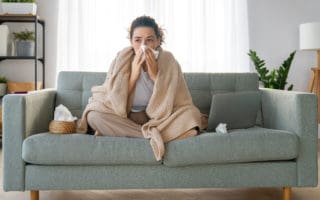
Ill upset girl is holding paper tissue and blowing nose. Virus symptom concept.
November 12, 2024 was World Pneumonia Day. Experts around the world were looking at how to deal with this often life-threatening condition.
In places like Nigeria and developing nations around the globe, pneumonia affects many people, especially young children. There are a number of key factors to consider. Air pollution is one of them.
With that in mind, we took a look at some of the material released by medical providers and related advocates, including the Every Breath Counts Air Pollution and Pneumonia Scorecard. This resource shows the correlation between air contaminants and illness.
Here are some of the statistics showing you what’s happening in places where air quality is especially low.
The Largest Risk Factor
Global studies show that in many countries, air pollution is the biggest factor in pneumonia deaths. It contributed to 30% of all recorded pneumonia deaths in 2021.
So this is not a small impact. It means that one of the ways to best prevent fatalities is to improve the air that people breathe on a regular basis. There are various ways to do this. We’ll talk about some.
Outdoor and Indoor Air Pollution
There are some discrepancies that researchers have noted about how air pollution contributes to respiratory harm in the form of pneumonia. Keep in mind that modern science also shows how air purifiers can practically reduce contaminants.
Some studies have shown that outdoor air and indoor air contribute to death at about the same rates, overall, per population, given similar impacts.
“Deaths of Nigerian children under-five due to overall air pollution-related pneumonia were 67,416 in 2019 while deaths of Nigerian children under-five due to household-specific air pollution-related pneumonia were 49,591 during the same year,” reported UNICEF in an article covering this kind of risk.
What African studies and other research finds is that many of those harmed at a young age are experiencing problems due to indoor cooking practices. When you cook around an open fire or some sort of wood combustion or other carbon fuel source, that releases small particles that can be harmful to a person’s respiratory system.
However, researchers also found that for adults, outdoor air pollution can be more deadly.
Global Risk Pockets
The scorecard study found that most air-pollution-related pneumonia deaths are happening in a list of 20 countries, where about half of these are in Africa. The remaining nine countries are in Asia, with one high risk country in Latin America. That’s Brazil.
Tackling the Problem
The study also calls for action targets and government benchmarks as a way to limit outdoor air pollution.
“Unless we take action now to reduce pneumonia deaths and the risk of another respiratory pandemic killing more than 10 million people – which experts say is 66% likely in the next 25 years – millions more adults and children will die from pneumonia,” advocates write. “It won’t be easy…”
Why Does Air Pollution Contribute to Pneumonia?
Pneumonia is an illness that attacks the lungs.
Air pollution weakens the respiratory system. It hurts the body’s ability to fight lung infections.
Specifically, too, there’s PM2.5. It comes in the form of small particles released from wood or carbon combustion. It gets trapped deep in the lungs, doing particular harm. In short, it’s dangerous.
Different types of chronic damage involve damage to the cilia, small hair-like items that line the respiratory tract. The inflammation has a range of adverse health effects. This is something to look out for at any age.
Some of the worst contaminants come in the form of the aforementioned small particles called PM 2.5. Also, toxic gases like soft dioxide and nitrogen dioxide.
This, plus exposure to pathogens, can lead to a more severe case of pneumonia that can be difficult to fight.
Improving Your Indoor Air
Aside from efforts to clean up the air in your community, there are ways to improve a household’s indoor air. Work to increase the health and longevity of everyone who lives there.
It starts with using an air monitor to identify the contaminants. You’ll want to see how bad the situation is inside of a building. Then you can use either floor-standing appliances or whole house air purifiers to get rid of various types of contaminants and even pathogens.
For example, air purifiers have been seen to be effective even against mold and PM2.5 particles released from things like wildfire combustion.
The new science is so overwhelming that a lot of businesses in America are using air purifier machines to make their spaces more welcoming to visitors.
The same can be effective in residential settings. Households can get better breathable air by putting these appliances in place. Some even have new technology like probiotics, filterless elimination of contaminants, etc. There are also standard benchmarks for pathogen and microbe control, where for example, a SuperHEPA filter is 99.99% effective for .1 microns, and a standard HEPA is 99.97% effective for .3 microns.
Let US Air Purifiers LLC help you with warranties and models and everything else. We know how to consult with customers to help them to get just what they need out of an air purifier purchase. Take a look at all of the technology that you can use to breathe easier in your home!